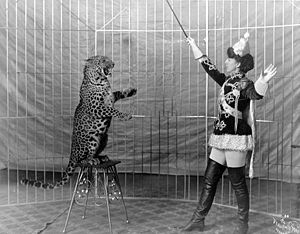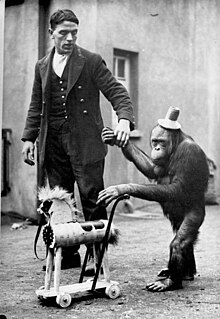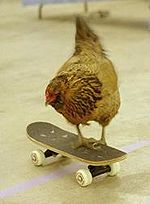
Burrhus Frederic Skinner was an American psychologist, behaviorist, inventor, and social philosopher. Considered the father of Behaviorism, he was the Edgar Pierce Professor of Psychology at Harvard University from 1958 until his retirement in 1974.
Operant conditioning, also called instrumental conditioning, is a learning process where voluntary behaviors are modified by association with the addition of reward or aversive stimuli. The frequency or duration of the behavior may increase through reinforcement or decrease through punishment or extinction.

An operant conditioning chamber is a laboratory apparatus used to study animal behavior. The operant conditioning chamber was created by B. F. Skinner while he was a graduate student at Harvard University. The chamber can be used to study both operant conditioning and classical conditioning.
Classical conditioning is a behavioral procedure in which a biologically potent physiological stimulus is paired with a neutral stimulus. The term classical conditioning refers to the process of an automatic, conditioned response that is paired with a specific stimulus.
In reinforcement theory, it is argued that human behavior is a result of "contingent consequences" to human actions. The publication pushes forward the idea that "you get what you reinforce". This means that behavior, when given the right types of reinforcers, can be changed for the better and negative behavior can be reinforced away.
Radical behaviorism is a "philosophy of the science of behavior" developed by B. F. Skinner. It refers to the philosophy behind behavior analysis, and is to be distinguished from methodological behaviorism—which has an intense emphasis on observable behaviors—by its inclusion of thinking, feeling, and other private events in the analysis of human and animal psychology. The research in behavior analysis is called the experimental analysis of behavior and the application of the field is called applied behavior analysis (ABA), which was originally termed "behavior modification."
The experimental analysis of behavior is a science that studies the behavior of individuals across a variety of species. A key early scientist was B. F. Skinner who discovered operant behavior, reinforcers, secondary reinforcers, contingencies of reinforcement, stimulus control, shaping, intermittent schedules, discrimination, and generalization. A central method was the examination of functional relations between environment and behavior, as opposed to hypothetico-deductive learning theory that had grown up in the comparative psychology of the 1920–1950 period. Skinner's approach was characterized by observation of measurable behavior which could be predicted and controlled. It owed its early success to the effectiveness of Skinner's procedures of operant conditioning, both in the laboratory and in behavior therapy.
Behaviorism is a systematic approach to understanding the behavior of humans and other animals. It assumes that behavior is either a reflex evoked by the pairing of certain antecedent stimuli in the environment, or a consequence of that individual's history, including especially reinforcement and punishment contingencies, together with the individual's current motivational state and controlling stimuli. Although behaviorists generally accept the important role of heredity in determining behavior, they focus primarily on environmental events.

Clicker training is a positive reinforcement animal training method based on a bridging stimulus in operant conditioning. The system uses conditioned reinforcers, which a trainer can deliver more quickly and more precisely than primary reinforcers such as food. The term "clicker" comes from a small metal cricket noisemaker adapted from a child's toy that the trainer uses to precisely mark the desired behavior. When training a new behavior, the clicker helps the animal to quickly identify the precise behavior that results in the treat. The technique is popular with dog trainers, but can be used for all kinds of domestic and wild animals.

Dog training is a kind of animal training, the application of behavior analysis which uses the environmental events of antecedents and consequences to modify the dog behavior, either for it to assist in specific activities or undertake particular tasks, or for it to participate effectively in contemporary domestic life. While training dogs for specific roles dates back to Roman times at least, the training of dogs to be compatible household pets developed with suburbanization in the 1950s.
Shaping is a conditioning paradigm used primarily in the experimental analysis of behavior. The method used is differential reinforcement of successive approximations. It was introduced by B. F. Skinner with pigeons and extended to dogs, dolphins, humans and other species. In shaping, the form of an existing response is gradually changed across successive trials towards a desired target behavior by reinforcing exact segments of behavior. Skinner's explanation of shaping was this:
We first give the bird food when it turns slightly in the direction of the spot from any part of the cage. This increases the frequency of such behavior. We then withhold reinforcement until a slight movement is made toward the spot. This again alters the general distribution of behavior without producing a new unit. We continue by reinforcing positions successively closer to the spot, then by reinforcing only when the head is moved slightly forward, and finally only when the beak actually makes contact with the spot. ... The original probability of the response in its final form is very low; in some cases it may even be zero. In this way we can build complicated operants which would never appear in the repertoire of the organism otherwise. By reinforcing a series of successive approximations, we bring a rare response to a very high probability in a short time. ... The total act of turning toward the spot from any point in the box, walking toward it, raising the head, and striking the spot may seem to be a functionally coherent unit of behavior; but it is constructed by a continual process of differential reinforcement from undifferentiated behavior, just as the sculptor shapes his figure from a lump of clay.
Extinction is a behavioral phenomenon observed in both operantly conditioned and classically conditioned behavior, which manifests itself by fading of non-reinforced conditioned response over time. When operant behavior that has been previously reinforced no longer produces reinforcing consequences the behavior gradually stops occurring. In classical conditioning, when a conditioned stimulus is presented alone, so that it no longer predicts the coming of the unconditioned stimulus, conditioned responding gradually stops. For example, after Pavlov's dog was conditioned to salivate at the sound of a metronome, it eventually stopped salivating to the metronome after the metronome had been sounded repeatedly but no food came. Many anxiety disorders such as post traumatic stress disorder are believed to reflect, at least in part, a failure to extinguish conditioned fear.
Instinctive drift, alternately known as instinctual drift, is the tendency of an animal to revert to unconscious and automatic behaviour that interferes with learned behaviour from operant conditioning. Instinctive drift was coined by Keller and Marian Breland, former students of B.F. Skinner at the University of Minnesota, describing the phenomenon as "a clear and utter failure of conditioning theory." B.F. Skinner was an American psychologist and father of operant conditioning, which is a learning strategy that teaches the performance of an action either through reinforcement or punishment. It is through the association of the behaviour and the reward or consequence that follows that depicts whether an animal will maintain a behaviour, or if it will become extinct. Instinctive drift is a phenomenon where such conditioning erodes and an animal reverts to its natural behaviour.

An avoidance response is a response that prevents an aversive stimulus from occurring. It is a kind of negative reinforcement. An avoidance response is a behavior based on the concept that animals will avoid performing behaviors that result in an aversive outcome. This can involve learning through operant conditioning when it is used as a training technique. It is a reaction to undesirable sensations or feedback that leads to avoiding the behavior that is followed by this unpleasant or fear-inducing stimulus.
In operant conditioning, punishment is any change in a human or animal's surroundings which, occurring after a given behavior or response, reduces the likelihood of that behavior occurring again in the future. As with reinforcement, it is the behavior, not the human/animal, that is punished. Whether a change is or is not punishing is determined by its effect on the rate that the behavior occurs. This is called motivating operations (MO), because they alter the effectiveness of a stimulus. MO can be categorized in abolishing operations, decrease the effectiveness of the stimuli and establishing, increase the effectiveness of the stimuli. For example, a painful stimulus which would act as a punisher for most people may actually reinforce some behaviors of masochistic individuals.
Marian "Mouse" Breland Bailey was an American psychologist, an applied behavior analyst who played a major role in developing empirically validated and humane animal training methods and in promoting their widespread implementation. She and her first husband, Keller Breland (1915–1965), studied at the University of Minnesota under behaviorist B. F. Skinner and became "the first applied animal psychologists." Together they wrote the book Animal Behavior which was first published in 1966, after Keller's death.
Errorless learning was an instructional design introduced by psychologist Charles Ferster in the 1950s as part of his studies on what would make the most effective learning environment. B. F. Skinner was also influential in developing the technique, noting that,
...errors are not necessary for learning to occur. Errors are not a function of learning or vice versa nor are they blamed on the learner. Errors are a function of poor analysis of behavior, a poorly designed shaping program, moving too fast from step to step in the program, and the lack of the prerequisite behavior necessary for success in the program.
In behavioral psychology, stimulus control is a phenomenon in operant conditioning that occurs when an organism behaves in one way in the presence of a given stimulus and another way in its absence. A stimulus that modifies behavior in this manner is either a discriminative stimulus or stimulus delta. For example, the presence of a stop sign at a traffic intersection alerts the driver to stop driving and increases the probability that braking behavior occurs. Stimulus control does not force behavior to occur, as it is a direct result of historical reinforcement contingencies, as opposed to reflexive behavior elicited through classical conditioning.
Discrimination learning is defined in psychology as the ability to respond differently to different stimuli. This type of learning is used in studies regarding operant and classical conditioning. Operant conditioning involves the modification of a behavior by means of reinforcement or punishment. In this way, a discriminative stimulus will act as an indicator to when a behavior will persist and when it will not. Classical conditioning involves learning through association when two stimuli are paired together repeatedly. This conditioning demonstrates discrimination through specific micro-instances of reinforcement and non-reinforcement. This phenomenon is considered to be more advanced than learning styles such as generalization and yet simultaneously acts as a basic unit to learning as a whole. The complex and fundamental nature of discrimination learning allows for psychologists and researchers to perform more in-depth research that supports psychological advancements. Research on the basic principles underlying this learning style has their roots in neuropsychology sub-processes.

Marine mammal training is the training and caring for marine mammals, such as dolphins, orcas, sea lions, and walruses.











